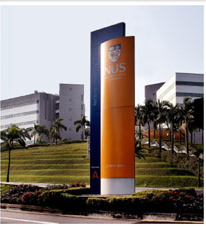 A study led by scientists at Singapore’s Duke-NUS Graduate Medical School (Duke-NUS) has shown that Hepatitis B Virus Infection (HBV) exposure increases the maturation of infants’ immune systems, potentially providing them with better survival odds when counteracting bacterial infections early in life. The Duke-NUS researchers’ findings radically modify the way that HBV vertical infection of neonates (mother-to-child) is understood, and present a paradigm shift in how treatment of patients with chronic hepatitis B is addressed.
A study led by scientists at Singapore’s Duke-NUS Graduate Medical School (Duke-NUS) has shown that Hepatitis B Virus Infection (HBV) exposure increases the maturation of infants’ immune systems, potentially providing them with better survival odds when counteracting bacterial infections early in life. The Duke-NUS researchers’ findings radically modify the way that HBV vertical infection of neonates (mother-to-child) is understood, and present a paradigm shift in how treatment of patients with chronic hepatitis B is addressed.
 The research, published in the journal Nature Communications on 25 March 2015, was led by Professor Antonio Bertoletti of the Duke-NUS Graduate Medical School Emerging Infectious Diseases Program (EID)
The research, published in the journal Nature Communications on 25 March 2015, was led by Professor Antonio Bertoletti of the Duke-NUS Graduate Medical School Emerging Infectious Diseases Program (EID)
The Nature Communications paper, entitled “Trained immunity in newborn infants of HBV-infected mothers“ (Hong, M. et al. Nat. Commun. 6:6588 doi: 10.1038/ncomms7588 – 2015), is coauthored by Dr. Bertoletti and Michelle Hong who are also affiliated with the Singapore Institute for Clinical Sciences, Agency for Science, Technology and Research (A*STAR), and their Emerging Infectious Diseases (EIDDuke-NUS Graduate Medical School Program colleagues Elena Sandalova, Adam J. Gehring, and Yap-Seng Chong; Diana Low and Ernesto Guccione of School of Immunity and Infection, College of Medical and Dental Science, University in Birmingham, UK and the UOC Ostetricia e Ginecologia, Dipartimento Materno Infantile, Azienda Ospedaliero-Universitaria di Parma at Parma, Italy; Stefania Fieni of the UO Immunoematologia e Medicina Trasfusionale, Dipartimento Diagnostico, Azienda Ospedaliero-Universitaria di Parma; Barbara Amadei and Simonetta Urbani of the Yong Loo Lin School of Medicine Department of Obstetrics and Gynaecology at the National University of Singapore; Yap-Seng Chong of the National University of Singapore Yong Loo Lin School of Medicine Department of Biochemistry
The researchers note that a newborn child’s immune system is characterized by impaired Th1-associated immune response, and Hepatitis B virus (HBV) transmitted from infected mothers to newborns is conventionally thought to exploit the newborns’ immune system immaturity by inducing a state of immune tolerance that facilitates HBV persistence.
However, contrary to that hypothesis, the scientists demonstrate in their study that HBV exposure in utero triggers a state of trained immunity, characterized by innate immune cell maturation and Th1 development, which in turn enhances the ability of cord blood immune cells to respond to bacterial infection in vitro. The data reveal a potentially symbiotic relationship between HBV and its natural host, and highlight the plasticity of the fetal immune system following viral exposure in utero.
The paper coauthors observe that infants have greater susceptibility to severe infections than do adults due to functional differences in their immune systems. Hepatitis B virus (HBV) infection is a serious global health problem that causes liver inflammation and cancer in chronically infected adults, and because a large proportion of HBV chronic infections are acquired at birth, HBV is regarded as a prototypical pathogen believed to hijack the neonatal immune system’s immaturity and establish a persistent infection through the induction of an immunotolerant state in the host.
But the researchers have determined that the dogma of immune defects induced by HBV is at odds with the efficacy of HBV vaccination in infants born to HBV+ mothers and with observations obtained in malaria-HBV co-infected young subjects. They note that recent data also indicate that chronically HBV-infected adolescents labelled as immunotolerant do not display any tolerogenic T-cell features.
In addition to these inconsistencies between experimental data in HBV models and data obtained during natural infection, the coauthors say there is increased recognition that the neonatal immune system is not defective, but rather that it presents unique functional features, and the functional maturation of neonatal immunity can be modulated by external factors. For example, bacterial colonization and vaccinations with live vaccines can decrease infant mortality and protect them against unrelated pathogens by inducing an increased functional efficiency of their innate immune system that has been termed trained immunity.
To directly characterize the impact of HBV exposure on the newborn immune system, the scientists performed a comprehensive immunological analysis of the cord blood (CB) cells from neonates of HBV chronically infected mothers. They report that HBV exposure in utero does not induce generic immunological defects but, on the contrary, is associated with a mature immunological profile that enhances the ability of the neonatal immune cells to respond to unrelated pathogens in vitro.
The research colleagues caution that more data still needs to be gathered in order to fully understand the impact of vertical HBV infection on its host, and note that limitation of their study is that as HBV-exposed neonates must be vaccinated and treated within 24 hours of birth. They were unable to investigate the consequences of the establishment of a persistent HBV infection after birth, noting the possibility that establishment of chronic HBV infection in neonates may be associated with a more robust and persistent Th1 response and a better ability to control unrelated pathogens, or it may be associated with defects in the priming of adaptive immunity, as has been shown in HBV-transgenic mice, but affirm that certainly a more precise evaluation of the immunological events that are occurring in the early phases of HBV infection is needed, and the question of how HBV exposure is inducing trained immunity is thus still open.
Nevertheless, they maintain that despite these limitations, their data clearly show a novel interaction between HBV and its human host, and that evidences of immune system maturation in newborns as a result of HBV exposure in utero suggests the presence of a symbiotic relationship between HBV and humans, similar to that demonstrated in mice with persistent herpes simplex virus infection. They suggest that symbiotic hostvirus interaction could explain why HBV has been so efficient in co-existing in a large part of the human population from its dawn.
Hepatitis B is one of the worlds most common and serious infectious diseases, with 350 million people suffering from chronic HBV infection worldwide, approximately 75 percent of them in Asia. For example, six in 100 Singaporeans are chronic carriers. A quarter go on to develop serious liver diseases, causing about a million deaths each year.
Research in. Dr. Bertoletti’s laboratory focuses on understanding the role of T cells in HBV pathogenesis and on developing immune therapeutic strategies for treating chronic HBV infection. Different methodological approaches (high dimensional flow cytometry, gene expression profile, laser microdissection) are utilized to analyze the HBV-specific T cell repertoire and the function of HBV-specific CD8 T cells in different clinical conditions. The lab team is particularly interested to redefine the function of T cells in the liver environment and understand the molecular mechanisms responsible for T cell exhaustion. In addition, the laboratory is actively developing strategies to restore HBV-specific immunity in chronic HBV patients or to increase the bioavailability of cytokines/drugs into infected hepatocytes. Selection of virus-specific CD8 T cells from patients allows isolation of their T cell receptors that are then used to engineer TCR-redirected T cells for T cell immunotherapy.
The majority of HBV chronic infections in Asia are acquired at birth, and while a safe and effective vaccine is available, five percent to 10 percent of babies born to HBV positive mothers still contract the infection, and conventionally, HBV is thought to exploit the neonatal immune system’s immaturity of to establish persistent infection.
The coauthors observe that current guidelines from international liver associations recommend treatment for HBV carriers only when they show clear signs of active liver disease, typically after the age of 30 — based on assumptions that HBV is considered harmless until symptoms of the disease emerge, and that young patients are immune-tolerant to HBV, meaning they have no protective response to the virus and are unable to react to treatment.
However, Prof Bertoletti and his research colleagues, in collaboration with the National University Hospital (Singapore) and Universitaria di Parma (Italy), have showed that contrary to current belief, infants exposed to HBV are not immune-tolerant but actually have more mature immune systems.
Examining immune cells in the cord blood of HBV positive mothers, the research team and discovered that both innate and adaptive immune cells are more activated and mature, and respond better to bacteria challenge, a phenomenon called ‘trained immunity.’ These results suggest that the exposed infants’ immune cells may be more acclimatized to dealing with potential bacterial infections than the cells from cord blood of healthy mothers.
First author, Duke-NUS Research Fellow Michelle Hong, says she is encouraged about contributing to understanding of a disease that is endemic in Asia. “Our work contributes to the understanding of how HBV exposure before birth shapes the global immune response of newborn infants and transforms the way we look at HBV. Despite causing diseases later in life, HBV might actually be beneficial to humans early in life,” she comments in a Duke-NUS release.
Previously, Prof Bertoletti had shown that young adults (aged 14 to 30) with chronic HBV infection are not immune tolerant and possess immune cells able to counter the virus. Moving forward, he plans to examine the impact of HBV infection in pediatric patients aged two to 12 in order to determine how their immune systems respond to the virus. The Nature Communications paper coauthors say that combined data from these different studies is poised to shape chronic HBV treatment guidelines for patients starting from young adults or even earlier.
This research is supported by the Singapore National Research Foundation under its STaR Investigator Award (NMRC/STaR/0013/2012) administered by the Singapore Ministry of Health’s National Medical Research Council and the Agency for Science, Technology and Research.
In 2000, Singapore launched an ambitious Biomedical Sciences Initiative designed to make the country the biomedical hub of Asia, and to attract both research and health sector manufacturing capabilities to Singapore. In the Initiative, the government planned to spend more than S$3 billion over five years to accelerate development in the biomedical sciences, offered incentives to attract companies to Singapore, and funded research institutes devoted to genomics, bioinformatics, bioengineering, nanotechnology, molecular and cell biology, and cancer therapies.
In 2001, a Medical Education Review Panel chaired by Lord Oxburgh of England evaluated the plan and recommended that Singapore establish a graduate medical school (Duke-NUS) to produce the highly trained medical leaders needed to support the Biomedical Sciences Initiative. Duke-NUS is intended to complement the National University of Singapore’s existing undergraduate medical school, based on the British model of medical education, in which students enter medical school after completing their Singapore-Cambridge General Certificate of Education (GCE) Advanced Level examinations (or equivalent) and then pursue a five-year curriculum towards a medical degree. The Ministry of Education believed that establishment of a graduate medical school would increase the supply of doctors practicing in Singapore, give the country the flexibility to produce more physicians to meet future needs, and train doctors who are exposed to clinically-related research, thus increasing the nation’s capacity to develop a vibrant biomedical hub.
 Duke and the National University of Singapore signed a formal agreement in April 2005 under which the two institutions would partner to establish a new medical school in Singapore. Under the agreement, the Singapore government has made a significant investment over the first seven years to establish Duke-NUS as part of Singapore’s strategy to become a leading centre for medical research and education.
Duke and the National University of Singapore signed a formal agreement in April 2005 under which the two institutions would partner to establish a new medical school in Singapore. Under the agreement, the Singapore government has made a significant investment over the first seven years to establish Duke-NUS as part of Singapore’s strategy to become a leading centre for medical research and education.
The school’s curriculum is patterned after that of the Duke University School of Medicine, and while the school is part of the National University of Singapore system, it is unique in that it is overseen by a Governing Board, including a Duke representative who has veto power over any academic decision made by the Board.
Sources:
Duke-NUS Graduate Medical School (Duke-NUS)
Nature Communications
Image Credits:
Duke-NUS Graduate Medical School (Duke-NUS)

